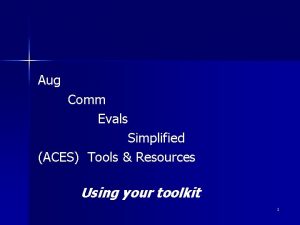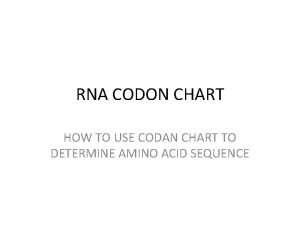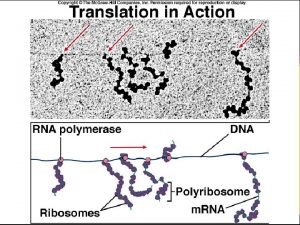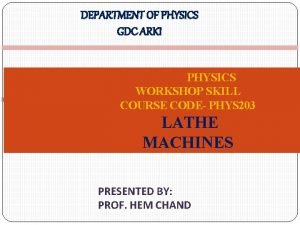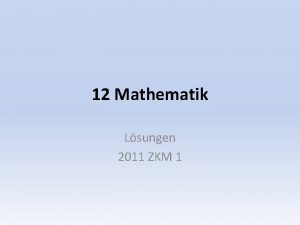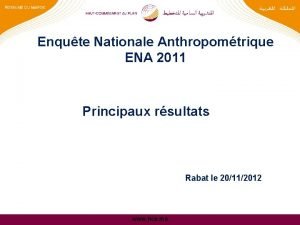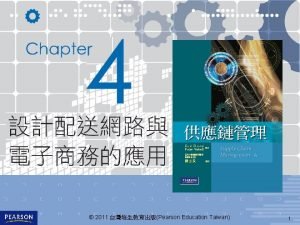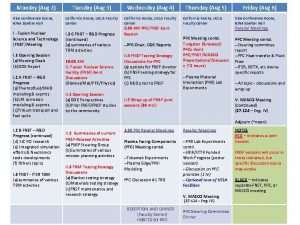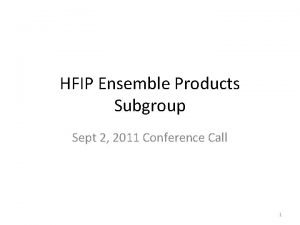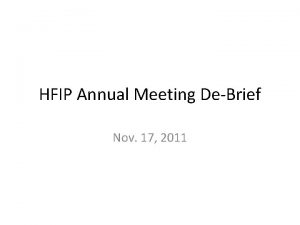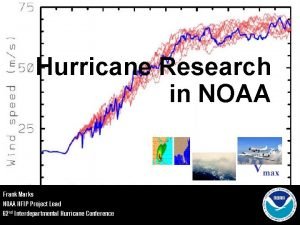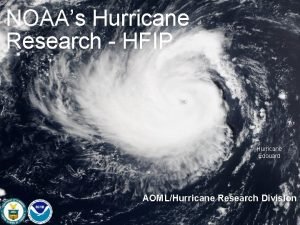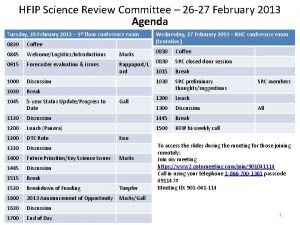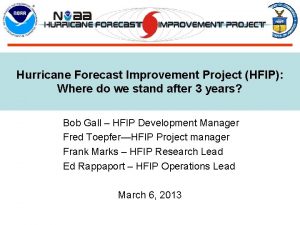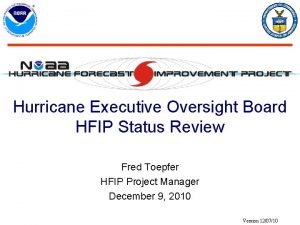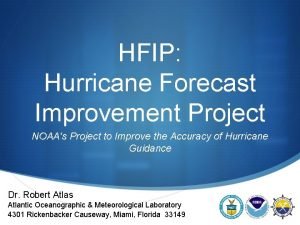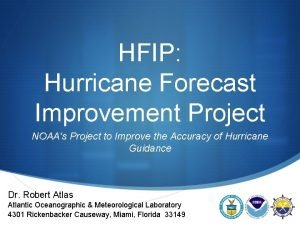2011 HFIP physics workshop Aug 9 11 Young














- Slides: 14

2011 HFIP physics workshop (Aug 9 -11) Young Kwon and HFIP regional modeling team 1

Main topics of the workshop: 1. Boundary Layer parameterization 2. Cloud Microphysics schemes During planning stage, HFIP regional team wanted to have a workshop with 1) set the clear goals and stick to them, and 2) less presentations with more discussion sessions. 2

Purpose of the workshop 1. Identify the roles of boundary layer and microphysical processes in hurricane modeling – what we know/don’t know and how to improve them 2. Facilitate the collaboration between the operational and research community – transferring development in research sector to the operational hurricane models 3

Questions to be answered: 1. 2. 3. 4. 5. 6. Are the current PBL schemes used in the hurricane models appropriate to hurricane environment, such as high wind shear and moist adiabatically neutral environment? If inappropriate, what kind of scheme is good and why? (e. g. the nonlocal PBL used in HWRF and GFDL models tends to have too tall PBL and too diffusive compare to observation) Are roll-vortices in a highly sheared hurricane boundary layer playing an important role? Is worth to investigate? Do microphysical processes play vital role in hurricane track and intensity? Do we need higher-moment MP scheme in order to get the realistic simulation of hurricanes? What are the pros and cons for higher moment and lower moment schemes? Is it worth to use bin-microphysics schemes in order to calibrate the bulk -microphysics scheme? 4

The list of Participants for 2011 HFIP physics workshop Morris Bender (GFDL) Jian-Wen Bao (ESRL) Jim Doyle (NRL) Isaac Ginis (URI) Young Kwon (EMC) Gopal (HRD) : remote Ligia Bernardet (DTC) Rob Rodgers (HRD): remote Robert Tuleya (EMC/ODU) Steve Lord (EMC) Pam Johnson (UCAR) Robert Gall (HFIP) Brad Ferrier (EMC) Vijay Tallapragada (EMC) Zhang (EMC) Chanh Kieu (EMC) Joingil Han (EMC) Qingfu Liu (EMC) Eric Aligo (EMC) Janna Occonor (EMC) Jun Zhang (HRD) : remote Mark Demaria (CIRA) : partly Yi Jin (NRL) Jimmy Dudhia (NCAR) Biswas (DTC) Wallace Hogsett (NHC) Frank Marks (HRD) David Zelinsky (NHC) Thomas Galaneau (NCAR) William Lapenta (EMC) William Kuo (DTC): remote David Nolan (U. Miami) SS Park (NCAR) Greg Thompson (NCAR) Svetla Hristova-Veleva (JPL) Ralph Foster (U. Washington) Scott Braun (NASA) Jason Sippel (NASA) Rob Fovell (UCLA) Alexander khain (U. Hebrew) Chris Fairall (ESRL) Total: 41 (EMC, GFDL, NRL, ESRL, HRD, DTC, NASA, CIRA, HFIP, NCAR, NHC, JPL, and 6 Universities) 5

Workshop Format First day: PBL, Second day: Microphysics First Session : Perspective from Operational Models overview of the PBL schemes in hurricane models (30 min) Brief descriptions of the operational schemes (10 min each) Second Session: Discussion (1. 5 hour or more) Third Session : research point of view Talks from research community (15 min each) Fourth Session: Discussions (2. 5 hour or more) 6

Third day 9: 00 – 10: 30 Discussions on the action items: 9: 00 - 9: 30 Collaboration between research and operation 9: 30 – 10: 30 Discussion How to proceed physics development in hurricane model How to facilitate collaborations of research and operation sectors The role of HFIP regional modeling team 10: 30 – 11: 00 Morning Break 11: 00 - 12: 00 Plan for the possible next year’s workshop 7

PBL sessions (1) Are the current PBL schemes used in the hurricane models appropriate to hurricane environment, such as high wind shear and moist adiabatically neutral environment? 1) No. The current PBL schemes of the operational models are too diffusive and too high PBL top compare to the observations. 2) The short term plan would be tuning the parameters to make PBL structure close to the observation, such as reducing momentum diffusivity (Km) by HRD, modify critical Richardson number/mixing length by EMC and other coefficients. Also, it may be possible to test upgraded version of the operational schemes such as YSU or newly developed GFS scheme. 3) The long term plan would be 1) testing the more complicated and appropriate local mixing schemes such as MYJ, KPP schemes, 2) performing the sophisticated diagnostics of PBL structure to find out the potential areas of improvement, 3) expand the capability of making use of observation data. 8

PBL sessions (2) If inappropriate, what kind of scheme is good and why? 1) Local mixing schemes are recommended as the best option. According to the sensitivity tests by Dave Nolan, Mellor-Yamada-Janjic (NYJ) scheme was recommended because they produce the closest PBL structure to the observation. However, the previous test had shown that MYJ scheme degraded the track forecast skill. Need to be tested in the current model configuration because the model changed with time. 2) If a local mixing scheme still degraded the track prediction skills, it indicates that large scale flow is appropriate to use of non-local scheme while a local mixing scheme is suitable for the hurricane environments. Therefore, there should be an effort to develop a scheme which works both in hurricane and large scale flows. 9

PBL sessions (3) Are roll-vortices in a highly sheared hurricane boundary layer playing an important role? Is worth to investigate? 1) Yes, the roll vortices are common in hurricane boundary layer, and once they form the vertical mixing profile may change a lot. 2) It is worth to investigate. However, it seems that the proper representation of the roll vortex effect would be long way to go because of lack of the observation and theoretical foundation yet. Some researchers (Isaac, Foster, Jun, Lorsoro) made some progress. 3) In order to parameterize roll vortices, we need to know the condition of forming, horizontal and vertical scale, and time scale of life span. More observations are needed. 10

Microphysics sessions (1) Do microphysical processes play vital role in hurricane track and intensity? 1) Yes, the microphysical processes can have huge impact on the intensity and track of the simulated hurricane according to the sensitivity study shown by Prof. Fovell. Therefore, the right microphysics scheme is essential to the hurricane models for producing the skillful hurricane forecast. Also, it was recognized that interaction with convection scheme and radiation scheme are also important. 2) The importance of observation and diagnostics are recognized as in the PBL sessions. Because of the difficulties in measuring hydrometeo-species in hurricanes, more works are needed to evaluate the current microphysics schemes. 3) There are some available observation data mostly from satellites archive at NASA, JPL and HRD. We need help from the research communities for evaluation using these data. 11

Microphysics sessions (2) Do we need higher-moment MP scheme in order to get the realistic simulation of hurricanes? What are the pros and cons for higher moment and lower moment schemes? Is it worth to use bin-microphysics schemes in order to calibrate the bulkmicrophysics scheme? 1) Higher moment schemes seems performing better than single moment schemes. Because of the limitation of operational computer resources, however, it is not plausible that the operational models use higher moment schemes at this moment. 2) There should be two parallel efforts to improve the operational microphysics scheme. a) modify the tunable parameters based on observation data. These parameters are ice initiation parameter, include fractional cloudiness, interception coefficient, and other related parameters and b) tune the single moment scheme using the output of higher moment schemes. 3) Yes tuning of the bulk schemes using bin-microphysics will be very helpful. We need help of the research community in this effort with long term plan. 12

Microphysics sessions (3) Short term plan 1. Tuning the bulk microphysics schemes using higher moment schemes/observations 1) Use of varying intercept parameter 2) Modify collision/collection efficiency 2. Recommendations from Ferrier 1) Slower ice fall speed and faster rime fall speed 2) Advection of separate hydrometeo species 3) New cloud water-rain auto-conversion Long term plan 1. Utilize the output from bin-microphysics 2. Develop more sophisticated diagnostic tools 3. More rigorous evaluation of schemes are needed with observation data 4. Idealized simulations 5. Examine the interaction between other physics (convection, radiation. . ) 13

Operation-research collaborations 1) DTC will play an important role in facilitating the collaborations between research community and operational agency. 2) DTC will maintain the unified HWRF model repository (DTC currently focus on HWRF model). 3) DTC will sync the up-to-dated operational code to community repository for outside researchers to use the current operational model. 4) Develop the alternative physics suites for the operational model instead of individual scheme by the research community. 14
 Aug comm device
Aug comm device Universal codon chart
Universal codon chart Translasjon
Translasjon Pagsusuri sa kaligirang pangkasaysayan ng el filibusterismo
Pagsusuri sa kaligirang pangkasaysayan ng el filibusterismo Root word for amo
Root word for amo Aug q
Aug q Aug methionine start codon
Aug methionine start codon Gdc arki
Gdc arki University physics with modern physics fifteenth edition
University physics with modern physics fifteenth edition Physics ia sample
Physics ia sample Modern physics vs classical physics
Modern physics vs classical physics Conclusion of case study
Conclusion of case study Zentrale aufnahmeprüfung 2011 lösungen
Zentrale aufnahmeprüfung 2011 lösungen Ena 2011
Ena 2011 Pearson education 2011
Pearson education 2011
